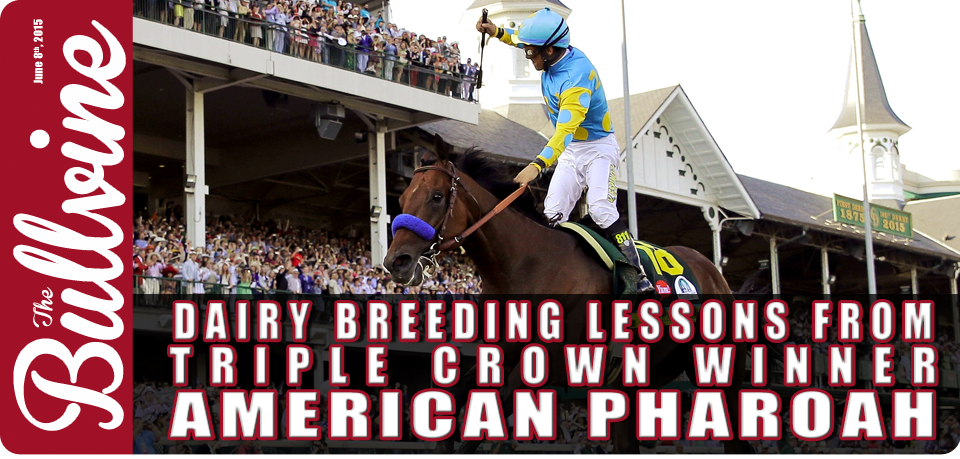It considered to be one of the greatest accomplishments in horse racing. All you have to do is win three races in five weeks. Until this Saturday, when American Pharoah did it, there had only been 11 of them in history and none in the past 37 years. In that same period, America has elected five presidents, fought three wars and lived through at least three economic downturns since Affirmed last completed the feat in 1978. In that time, there had been 12 horses enter the final leg of the Triple Crown, The Belmont Stakes, at the grand old racetrack in Long Island. Twelve with a chance to accomplish that feat but ultimately failed.
![screen-shot-2015-06-06-at-7-08-51-pm[1]](https://www.thebullvine.com/wp-content/uploads/2015/06/screen-shot-2015-06-06-at-7-08-51-pm1-300x300.jpg)
So How Did American Pharaoh’s Pedigree Help Him Win?
“The sire line is very stamina oriented, but the female line of descent — the dam, the second dam, the third dam — they’ve all been very speed oriented horses,” says Sid Fernando, president and CEO of thoroughbred research and consultant Werk Thoroughbred Consultants. “It’s a unique pedigree, in a way.”
American Pharoah’s pedigree includes horses adept at classic race distances on his sire’s side and endowed with speed on his dam’s side. Sire, Pioneerof the Nile, won the Santa Anita Derby and ran second in the 2009 Kentucky Derby, with all of his wins at distances of 1 1⁄16 or more. Prior to American Pharoah, Pioneerof the Nile had sired five other winners of stakes races of a mile or more in his relatively new career as a stallion. Through Pioneerof the Nile, American Pharoah is a grandson of Unbridled, who won the 1990 Kentucky Derby and the Breeders’ Cup Classic. He carries lines to Grade I champions Toussaud and Fappiano and to the top-rated European two- and a three-year-old colt of 1983 and 1984, El Gran Senor. He is also descended from Northern Dancer, Buckpasser, and Mr. Prospector—whose descendants have won 43 Triple Crown races—all through Empire Maker, Pioneerof the Nile’s sire, who won the 2003 Belmont Stakes. Ultimately, via Unbridled and his ancestors, American Pharoah’s sire line traces to the Darley Arabian.
Meanwhile, the bottom side of this pedigree is slanted toward sprint success. His dam, Littleprincessemma, by Yankee Gentleman, was unplaced in both of her career outings. Her only other starter is Xixixi, who scored both career wins at six furlongs. Littleprincessemma is a half-sister to graded stakes-winning sprinters Storm Wolf and Misty Rosette. Her own undistinguished racing career, combined with the modest record of her sire, Yankee Gentleman, dampened initial public expectations for her second-born foal. Yet American Pharoah’s maternal bloodline includes Storm Cat, a Grade I winner retired early due to injury, Northern Dancer, a Kentucky Derby and Preakness Stakes winner, and Terlingua, a celebrated broodmare, through whom he is a fifth-generation descendant of Secretariat. He is also descended through his dam from Flying Paster, a Grade I champion who was 1978 California Horse of the Year, and Exclusive Native (sire of Affirmed and Genuine Risk). Through both sire and dam, American Pharoah is a fifth- and sixth-generation descendant of Bold Ruler, as well as a sixth- and seventh-generation descendant of Tom Fool, one of the top thoroughbreds of the last century.
![american-pharoah-bob-baffert-ab8804342ee79687[1]](https://www.thebullvine.com/wp-content/uploads/2015/06/american-pharoah-bob-baffert-ab8804342ee796871-300x245.jpg)
What is going on is that, instead of very selective breeding for distance races as is practiced by most breeders dreaming of winning the Triple Crown one day, American Pharoah bucks that trend and his maternal line is more geared for short speed. This breeding was so outside of normal that, when American Pharoah was offered for sale at the August 2013 Fasig-Tipton Select Yearling Sale in Saratoga Springs, N.Y by Taylor Made Sales, no one wanted to pay the $300,000 reserve bid on him (Note: Taylor Made Sales was also the principal speaker at the recent Day at the Derby sale). American Pharoah was in the sales ring for all of five anticlimactic minutes. Horsemen from around the globe appraised the animal and refused to raise the bidding to the listed minimum sale price of $300,000 – a figure that would be reached or surpassed for 32 of the 151 other yearlings up for sale in the two-day event.
The thing that American Pharoah has in common with many of the greatest impact sires in the Holstein breed is that he bucks the conventional breeding pattern. Instead of doing balance on balance or long distance racehorse on a long distance racehorse, American Pharoah, looks to leverage the power of mating two opposite extremes together to raise the results even higher.
This is something many dairy breeders overlook when developing their dairy breeding strategy. Generation after generation most breeders like to use balanced sire on balanced sire and, while this will give you the most overall herd consistency, it will not deliver that one game-changing animal that will cause the world to take notice.
The Bottom Line
In today’s high-end genetics market, there is no question that the biggest money and most impact comes from sires that are built for extremes. Sure there will be those animals that don’t deliver but, for the ones that do, they will produce in a big way. American Pharoah demonstrates to us that it takes looking outside the box of what is expected. It means, selecting from the extremes to achieve extreme results.
Get original “Bullvine” content sent straight to your email inbox for free.






![ny2dsspp[1]](https://www.thebullvine.com/wp-content/uploads/2015/06/ny2dsspp1.jpg)
![american-pharoah-wins-the-triple-crown-1106777-TwoByOne[1]](https://www.thebullvine.com/wp-content/uploads/2015/06/american-pharoah-wins-the-triple-crown-1106777-TwoByOne1-600x300.jpg)












Leave a Reply
You must be logged in to post a comment.